Katie Clark and Sarah Rose Govero participated in the Mississippi Arts Commission’s 2022-2023 Folk Arts Apprenticeship Program. This grants program supports the survival and continued evolution of community-based traditional art forms. During the apprenticeship, the master artist teaches specific skills, techniques, and cultural knowledge to the apprentice, who is an emerging artist of the same tradition. Participants are awarded $2,000 to assist with the teaching fees for the master artist and other expenses such as travel costs and supplies. To learn more about the program, click here.
Introduction
Katie Clark defines crochet as “a process of making fabric with yarn, or sometimes thread using a series of loops, using a hook.” Her apprentice, Sarah Rose Govero adds, “It’s loops, a hook, and patience!” Both crocheters since childhood, the two met through their church. Katie invited Sarah Rose to be her apprentice and to develop a portfolio of work that reflects a high degree of competence, professional standards, and artistry suitable to present for jury review in the Craftsmen’s Guild of Mississippi. Sarah Rose completed four projects for her portfolio over the course of the apprenticeship, including garments, blankets, and a Christmas ornament.
Master Artist: Katie Clark
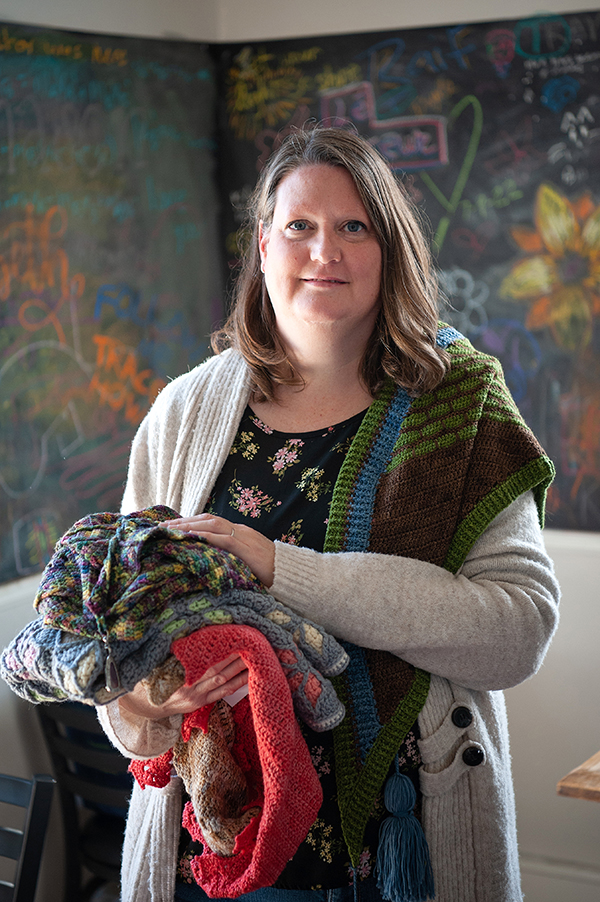
Above (main image): Sarah Rose Govero and Katie Clark
Right: Katie Clark
All photographs by Rory Doyle.
During their apprenticeship, Doyle took these photos of Katie and Sarah Rose at Cup’s coffee shop in Clinton, where they held some of their meetings together.
Once you get the stitches, the geometry, and basic structures down,
it’s really easy to own it.
Katie Clark learned the basics of both knit and crochet from her mom, but she “took to crotchet because it was faster,” explained Katie. In crochet, each stitch is completed before the next one is begun, whereas knitting keeps many stitches open at a time. From those basics, Katie began experimenting with single-crochet and double-crochet stitches. Then, she taught herself to read patterns, learning through books and trial-and-error. She spent many years trying out techniques and patterns on various types of projects. She learned how different methods of construction inform a final garment, such as a raglan sweater versus a sweater with set in sleeves.
After becoming more confident in her craft, she began to mix patterns and re-employ stitches to make something of her own. While she understands and appreciates the traditional roots of crochet, she likes to keep up with current styles of knit design to incorporate into her work. Beyond crochet and knit aesthetics, she also finds inspiration in “nerdom”, like early Atari video games. Katie enjoys creating unusual, asymmetrical shawls and figuring out how to create different shapes, darts, angles, and curves. She now designs her own patterns. Speaking on her process, Katies explained, “Once you get the stitches, the geometry, and basic structures down, it’s really easy to own it.”
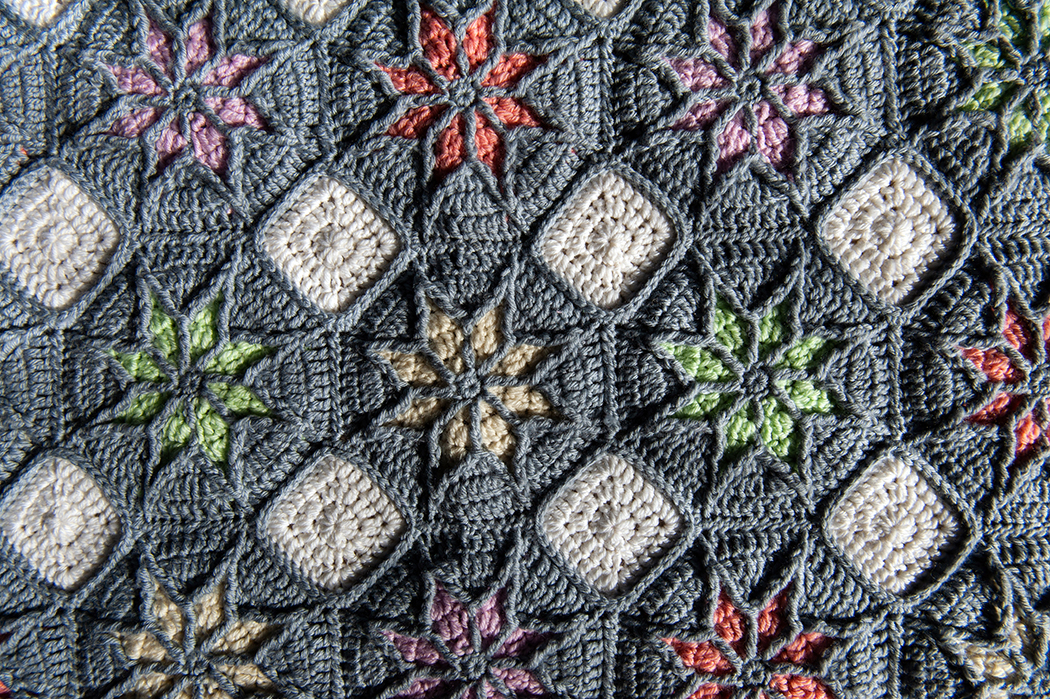
Above: Katie Clark’s crocheted afghan blanket
Katie has always appreciated that the skills came to her ultimately from her grandmother, who taught her mother to crochet. She recalls seeing her uncle, a woodworker, turn artful bowls and build beautiful dulcimers in Berea, Kentucky, and realized “what an honor it is to be part of a tradition of craft that spans generations.” Continuing the legacy of her grandmother and mother, she sees her role in passing the tradition of crotchet to future generations. She started teaching at a local yarn store in 2009 and has taught at regional fiber festivals around the South. In 2013, she joined the Craftsmen’s Guild, where she now teaches locally at the Bill Waller Craft Center in Ridgeland, Mississippi. She also serves on the board of the Craftsmen’s Guild, chairing the Education Committee. Reflecting her mastery, the classes she teaches “aren’t project based, they’re design based.” Katie added that her classes “show and encourage people how they can make crochet their own.”
Apprentice: Sarah Rose Govero
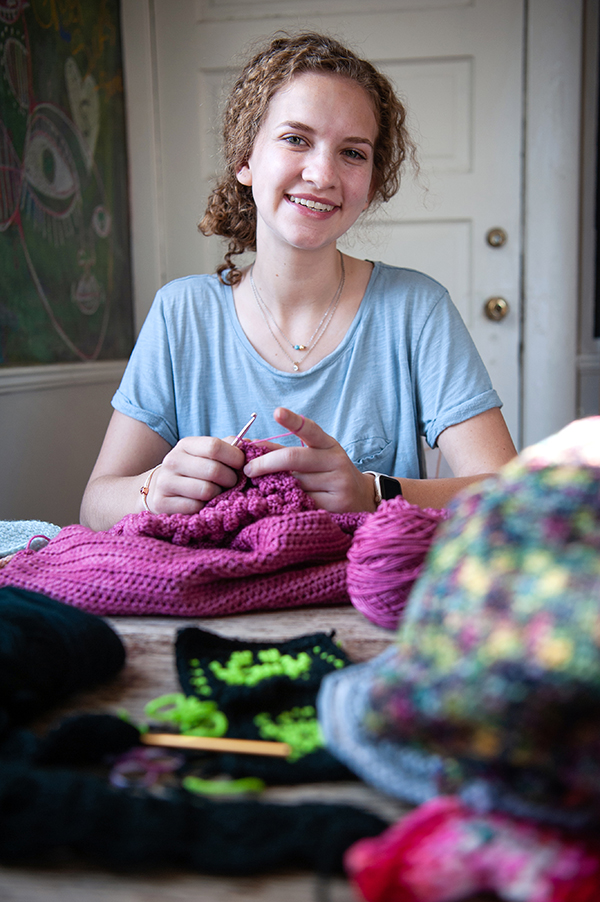
Left: Sarah Rose crocheting during one of her apprenticeship lessons
Sarah Rose grew up in Clinton, Mississippi. Now a recent high school graduate, she has been crocheting since she was 10. Sarah Rose admits that the way she picked up the art form is “kind of a funny story.” Her sister ran track at Mississippi College and brought her teammates over one night. One teammate was knitting, another was crocheting. Sarah Rose was fascinated watching them, and the crocheter said she would teach her. She then gave Sarah Rose a hook and a small ball of yarn and showed her the basic chain and single crotchet. From there, Sarah Rose learned the craft by watching YouTube videos. Katie cites an “interesting” generational gap between herself and her apprentice. Where Sarah Rose and her contemporaries learn from YouTube, Katie learned everything from books. The pair commented that this difference is “really cool,” and they see great potential in these two ways of learning.
Apprenticeship Experience
As a member of the Craftsmen’s Guild, Katie is often looking for ways to expand their membership and to give anyone with the desire the opportunity to expand their skill set. After learning about the Mississippi Arts Commission’s Folk Arts Apprenticeship Program, she knew right away that Sarah Rose would be an excellent candidate to work with in the program.
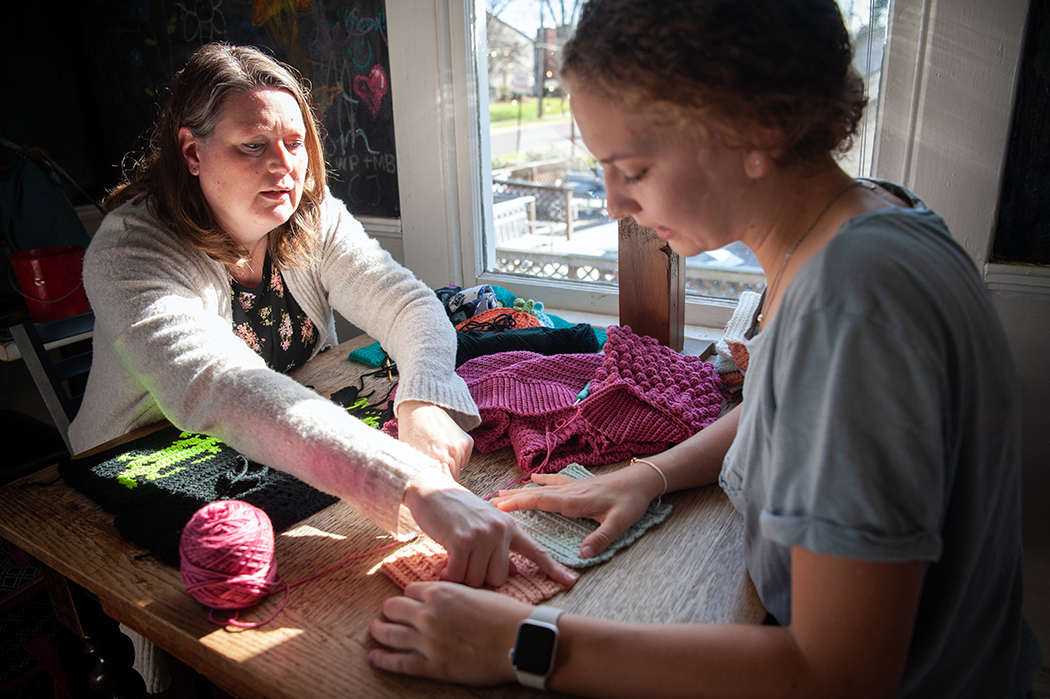
Right: Katie teaching Sarah Rose about crochet during one of their meetings
Sarah Rose said one reason she wanted to be an apprentice was to learn how to change crochet patterns and develop her own, like Katie. After completing the program, she feels that she has become more advanced in that regard. She made her first pattern during the apprenticeship – a 3D train Christmas ornament. The design was inspired by her hometown of Clinton: steam trains were historically economic drivers in her area. While the stitches were not new to her, she had never made a 3D design, which requires sewing different pieces together.
Their twice-monthly meetings sometimes took place in their houses but mainly occurred in their local coffee shop. They also texted a lot – especially with pictures of their projects. Sarah had a good foundation, she knew how to read patterns and core stitches, but Katie passed on knowledge of more stitches, how to introduce different textures, stitch gauges, how different fibers work and when to use them, and how to stitch together panels of crotchet to make garments. Their meetings were not as structured as a regular class Katie would lead because there was less of a time constraint in the weeks-long apprenticeship format. The sweater project meetings were longer than usual because Sarah Rose had not made a garment before, so the two had to work on measurements and sizing together. The sweater uses a traditional bobble stitch, but the balloon sleeves, raspberry color, and edging, make it a modern garment. Katie loves how Sarah Rose has employed traditional techniques in a “fresh” way. Sarah Rose is now working on a baby sweater which is entirely her own design. This new sweater project will also give her experience using hand-dyed wool, a fiber she has never used before.
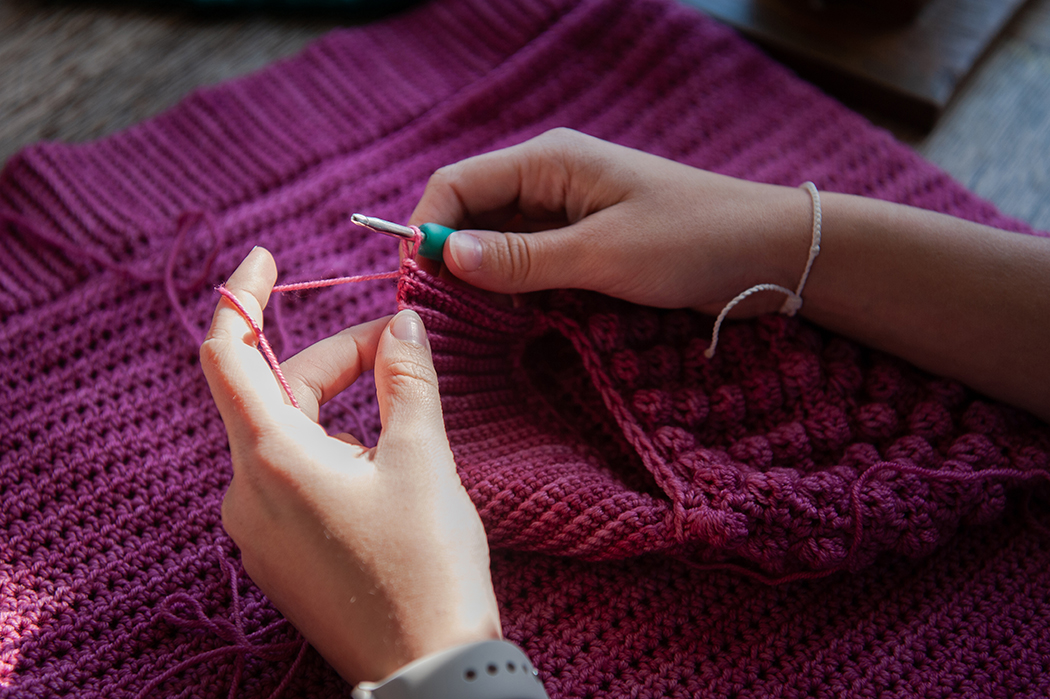
Left: Sarah Rose crocheting
According to Katie, there are decisions to be made in making every piece when crocheting – from big decisions like what yarn to use, down to tiny ones like what needle to employ. She notes the importance of having some foresight when crocheting, “Different joining techniques yield different results,” said Katie. “You have to know what it’s going to look like in the end to know which one is going to be most appropriate, or which you would be happiest with.” The two explained that patience, a willingness to try, and learning from your mistakes are key to being a good crocheter.
[Sarah Rose] started with the skills of a crochet hobbyist, but now she has the foundation and attitude of a crochet designer!
Conclusion
When asked what the apprenticeship means to her, Sarah Rose said, “It’s super exciting to branch out and try new things.” Being part of the guild and being part of a younger generation of crocheters means a lot to her. She imagines she will teach as she gets older to continue the craft. She also plans on majoring in interior design and hopes to put a piece of her crotchet in every home she designs as a kind of maker’s mark. Towards the end of their apprenticeship, Sarah Rose successfully submitted her application to the Craftsmen’s Guild of Mississippi, and like her mentor, she is now a guild member.
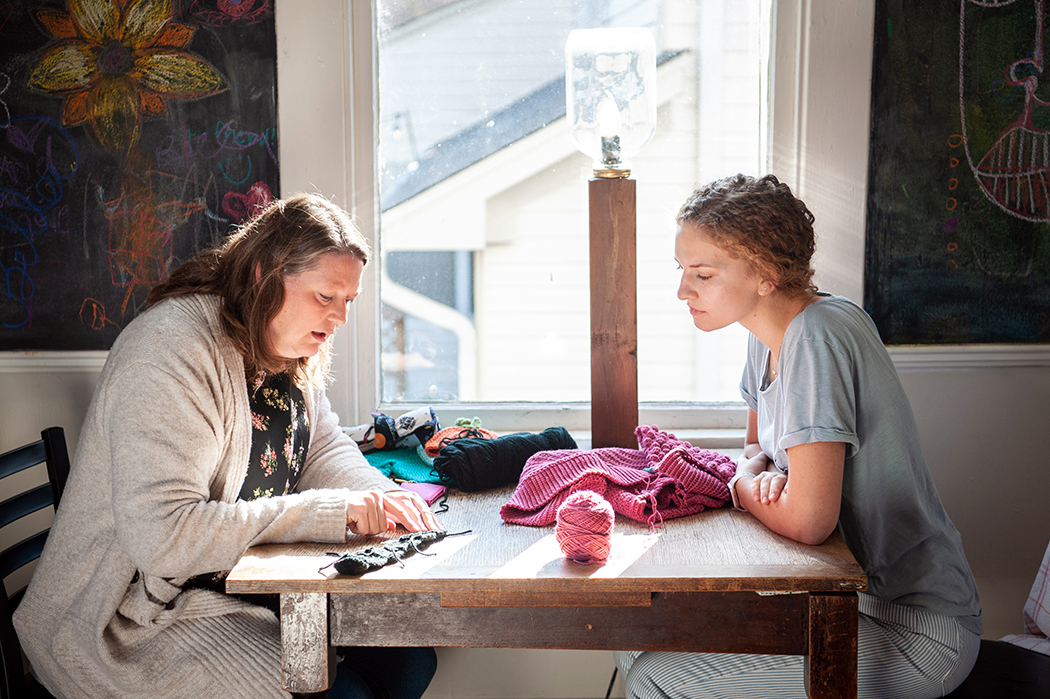
Right: Katie showing Sarah Rose some crochet techniques
When Katie reflects on the apprenticeship experience, she said “it’s been super fun guiding [Sarah Rose] through these processes of trying these new things. I’m super proud of what she’s learned and has been able to accomplish on her own and her problem solving and decision-making. She started with the skills of a crochet hobbyist, but now she has the foundation and attitude of a crochet designer!”

